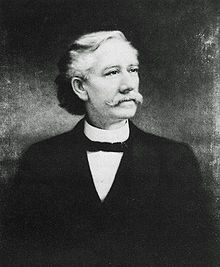Charles Triplett O'Ferrall
| Charles Triplett O'Ferrall | |
|---|---|

Portrait of Governor O'Ferrall
|
|
| 42nd Governor of Virginia | |
|
In office January 1, 1894 – January 1, 1898 |
|
| Lieutenant | Robert Craig Kent |
| Preceded by | Philip W. McKinney |
| Succeeded by | James Hoge Tyler |
| Member of the U.S. House of Representatives from Virginia's 7th district |
|
|
In office May 5, 1884 – December 28, 1893 |
|
| Preceded by | John Paul |
| Succeeded by | Smith S. Turner |
| Member of the Virginia House of Delegates from Rockingham County | |
|
In office 1872–1873 Alongside George Deneale |
|
| Personal details | |
| Born | October 21, 1840 Berkley Springs, Virginia |
| Died | September 22, 1905 (aged 64) Richmond, Virginia |
| Political party | Democratic |
| Alma mater | Washington College |
| Profession | Politician, Lawyer |
| Military service | |
| Allegiance |
|
| Service/branch | Confederate States Army |
| Years of service | 1861–1865 |
| Rank | Colonel |
| Battles/wars | American Civil War |
Charles Triplett "Trip" O'Ferrall (October 21, 1840 – September 22, 1905) was a Virginian politician who served as a U.S. Representative from 1883 to 1894 and as the 42nd Governor of Virginia from 1894 to 1898.
Charles O'Ferrall was born in Brucetown, Virginia (then in Frederick County, Virginia, now near Berkeley Springs, West Virginia) to John and Jane Laurens Green O'Ferrall. His father was an innkeeper and former member of the Virginia General Assembly who was elected Clerk of Court of Morgan County in 1851. O'Ferrell was educated in the local schools.
While recovering from a wound during the Battle of Upperville in the American Civil War in Enterprise, Mississippi, O'Ferrall met Annie Hand, whom he married on February 8, 1865 before returning to active duty. They had two children. After her death, in 1881 he married Jennie Wickliff Knight (1846 - 1908), with whom he had four more children, and who survived him.
When John O'Ferrall died suddenly in 1855, the local judge thought highly enough of Charles O'Ferrall to appoint the fifteen-year-old to hold the clerk's post until an election could be held. Charles O'Ferrall was sufficiently respected to later win election, at seventeen, to a full six-year term as Clerk of Court. However, he only served less than half the term before the civil war began.
Although Morgan County and what became West Virginia was predominantly pro-Union area, O'Ferrall felt his true allegiance to be to Virginia. Thus, he joined the Confederate side of the war. Enlisting as a private in the 12th Virginia cavalry, O'Ferrall was immediately offered the position of sergeant. He subsequently distinguished himself in several battles, leading to promotion to the rank of major and was allowed to form his own cavalry battalion, the 23rd Virginia Cavalry. By war's end, O'Ferrall was a colonel in command of all cavalry in the Shenandoah Valley. His regiment engaged in the last fight of the war on Virginia soil. O'Ferrall was also wounded eight times in battle, including once so seriously that he was left for dead.
...
Wikipedia
